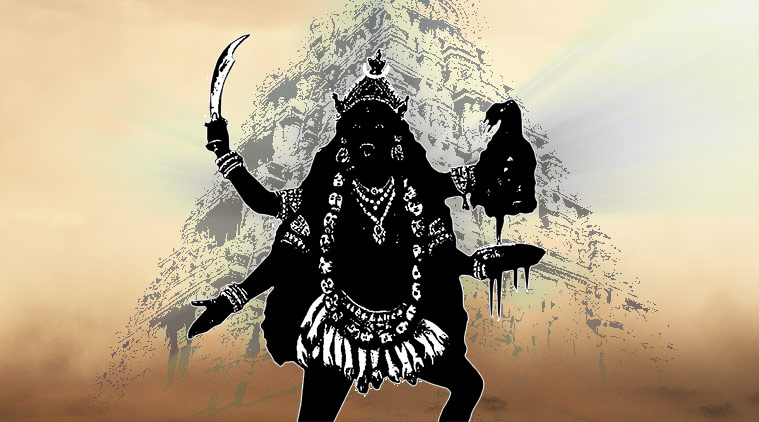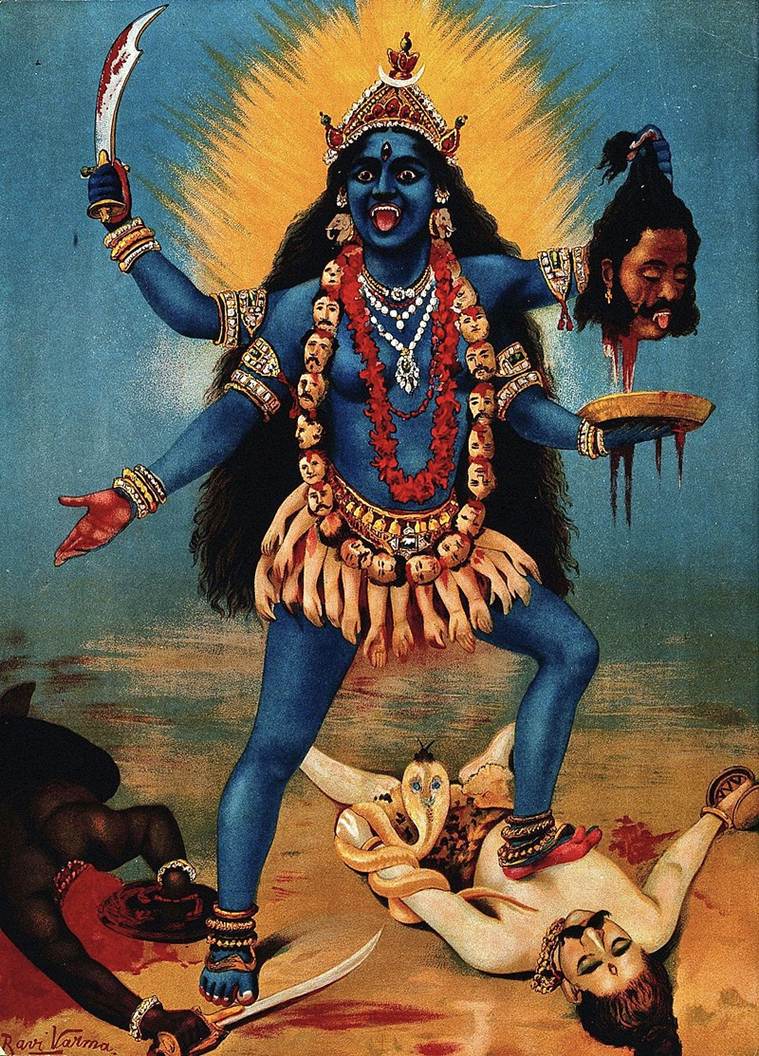 Agamavagisha is attributed with popularising the worship of a certain image of Kali in Bengal and is also believed to have started the oldest Kali puja in Bengal.
Agamavagisha is attributed with popularising the worship of a certain image of Kali in Bengal and is also believed to have started the oldest Kali puja in Bengal.
There is a widely held belief among Bengalis that the noted 16th century Tantric scholar, Krishnananda Agamavagisha had once dreamt of Goddess Kali. The Goddess, who was until then largely been associated with death and darkness, is believed to have instructed Agamavagisha to worship her in a form that incorporated in her forms of feminine domesticity. Agamavagisha is attributed with popularising the worship of a certain image of Kali in Bengal and is also believed to have started the oldest Kali puja in the region. The zamindars of later centuries took forward the tradition and turned them into ostentatious projects to showcase wealth and power. Till date, when India celebrates Diwali, it is Kali puja that is observed and celebrated with much pomp and pride in Bengal.
 The Thanthania Kali of Bengal. (Express photo by Arpan Ganguly)
The Thanthania Kali of Bengal. (Express photo by Arpan Ganguly)
The popularity of the Goddess among Bengalis is evidenced by the number of temples dedicated to her that dot across the geographical territory of Bengal, and even in those areas outside the state where the community dwells in large numbers. However, Kali can hardly be regarded as a Goddess of Bengal alone. In fact the form in which she is observed by most Bengalis is just one among the many facets that the deity is believed to have. As scholar of religious studies, June McDaniel notes, “Kali is a strange and mercurial figure”. “In northwestern India she is thin and ugly, while in Bengal she is voluptuous with large eyes and full lips. In some areas of India she is a tribal and village Goddess who protects a group of people, or a geographical region, and an ancestress who grants the desires of her people,” she writes in her article, ‘Kali: Goddess of life, death and transcendence’. She is also the yogic Goddess of death and transcendence and the Tantric deity who wears a necklace of skulls and belt of human hands and dances at the cremation ground.

“Kali’s present complexity of character developed slowly during the course of at least two thousand years,” writes Professor of Asian and Middle Eastern Cultures, Rachel McDermott in her book, ‘Encountering Kali: In the margins, at the center, in the west’. Historical and iconographic sources show that she was perhaps at the margins of Brahmanical society between the third century BCE and seventh century CE, recognised mostly as a tribal Goddess. The first time she appears somewhere within the folds of Brahmanical Sanskritic tradition is perhaps the sixth century BCE in the text ‘Devi Mahatmya’ which is part of the Markandeya Purana, where she is depicted to be Goddess Durga’s fury incarnate. In later centuries she is incorporated into Tantric ritual and philosophy and more recently by the seventeenth century CE, she is identified with devotional traditions, wherein she is observed as the loving mother. The divergences in the form and depictions that Kali denotes across different parts of the subcontinent is largely reflexive of the way in which her character developed and blended with local traditions and Hindu symbolism.
On the occasion of Diwali and Kali Puja, here is a look at three diverging depictions of Goddess Kali among several others in India.
Goddess Kali of Kalighat temple in Kolkata
Kalighat, the landing stage on the course of the river Hooghly in Calcutta is one of the most important seats of Goddess Kali and is visited by thousands of pilgrims every day. In Kolkata, unlike most parts of India, the demonic, cannibal-like qualities of Kali are toned down to depict an image that is dark and yet beautiful. “She is the perfection of youthful, charming, and feminine beauty,” writes scholar of Hindu studies, Sanjukta Gupta in her article ‘The domestication of a Goddess’.

 Kali trampling Shiva. Chromolithograph by Ravi Varma. ( Wikimedia Commons)
Kali trampling Shiva. Chromolithograph by Ravi Varma. ( Wikimedia Commons)
Gupta notes that in her several visits to Kalighat, she witnessed the ‘domestication’ of Kali by the family and kinsmen of the Haldars, the priestly clan who enjoy ownership of the temple and manage its affairs. She explains that the means of Kali worship at kalighat depictive of a fusion between the non-vegetarian Sakta tradition of Hinduism, also considered at Tantrism and the vegetarian Vaishnava tradition, both of which have had a strong influence over Bengal since the 17th century. Also, the Krishna Bhakti tradition of Chaitanya that became popular in Bengal since the 16th century, also made its impact felt in the way Kali came to be worshipped there. “As a result of both such Vaishnava influences, by the eighteenth century in Bengal Kali was transformed from a wild, ferocious deity of death to a benign youthful mother, albeit capricious and crazy,” writes Gupta.
Goddess Kali of Bhubaneswar in Orissa
In the temple town of Bhubaneswar, Kali is depicted with ten hands that are armed with weapons emblematic of male Gods, grasping a bloody decapitated head, with her foot placed on the chest of Siva. Scholars Usha Menon and Richard A Shweder in their work, ‘Dominating Kali: Hindu family values and Tantric power’ write that the Kali iconography in Bhubaneswar is unmistakably Tantric with its extreme representation of female power. However, it has almost completely been assimilated into the mainstream Hinduism as is practised today in Bhubaneswar. “Far from highlighting the potency of the female and her power to create and destroy with impunity, the icon is used to uphold Hindu family values, especially those encouraging female self-control and self-restraint,” write Menon and Shweder.
Further, Menon and Shweder suggest that the 15th century Oriya text, Chandi Purana provided the conceptual framework for a creative interpretation of the Tantric idol. Unlike the previous texts mentioning the Kali story, this particular story depicted Kali to be stepping upon Siva accidentally and that her expression is one of ‘lajja’ or shame. “It is awareness of that unequal domestic relationship that compels Kali to bite her tongue and hold in her anger,” write Menon and Shweder. The idea of ‘lajja’ in association with Kali is the most common perception of the icon today, and provides ways to discuss, organise and better understand several issues that are important to Oriya Hindu culture.
Bhadrakali of Southern India
In Southern India, Kali takes the form of Bhadrakali, whose story is remarkably different from the ones popular across India. Here she is observed as the auspicious form of Kali who is believed to protect the good. She is depicted as having three eyes and four, sixteen or eighteen hands. She has a small tusk protruding from her mouth and flames flowing from her head.
 In Southern India, Kali takes the form of Bhadrakali, whose story is remarkably different from the ones popular across India. (Wikimedia Commons)
In Southern India, Kali takes the form of Bhadrakali, whose story is remarkably different from the ones popular across India. (Wikimedia Commons)
Though the origin of Bhadrakali is believed to be in Devi Mahatmyam of the Sakta tradition, the most popular version of her story perceives her to be the daughter of Siva, born to liberate the world of the demon Daruka. It is believed that she was born out of Siva’s eyes with a ferocious look and countless hands. In Southern India several folk art and dance forms celebrate the event of her birth and her worship is believed to purify all devotees.
Also ReadA brief and crackling history of fireworks in IndiaIndia’s Rangoon connection: Memories of the thousands who took an uncerta…A short history of the Sardar Sarovar Dam on river NarmadaHere is what happened in Kedarnath, and rest of Uttarakhand, in 2013
Despite the varying ways in which Goddess Kali is depicted and celebrated across the country, is there a common thread that ties up the devotion to her? As McDermott reveals in her book “she maybe a bloodthirsty tribal deity, a goddess of esoteric tribal origins, the mother of devotional poets experiencing the political and social upheavals of eighteenth-century Bengal, or the terrible mother of universal female strength and rage, but in all cases, by her very multivalency, Kali expresses transformative power (sakti).”

